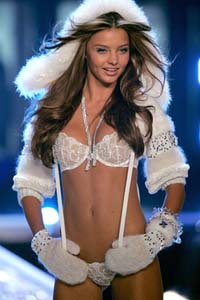
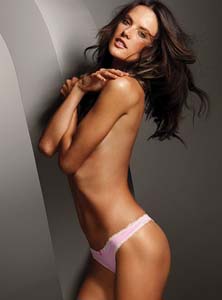
When observing the body types of all of the Victoria's Secret models, it is impossible not to notice the similarities between all of them: they are thin with long legs, flowing hair, and large breasts. By simply viewing these images not as advertisements for the lingerie that the models are wearing but as just the images themselves, "it is nearly impossible not to notice that women as represented in popular culture have gotten thinner and thinner" (Frith 227). However, it is also very apparent that in addition to the perpetuation of the thin ideal, Victoria's Secret also expects women to have full breasts, a feature uncommon among thinner women.
In addition to the previously mentioned discourse of feminine body ideals, Victoria's Secret advertising also contains a discourse of what women should be used for. Popular names for their different products include the words "sexy," "naked," and "nude," all words exemplifying the adjectives and states of being that American women are supposed to embody. Using these words and the supposedly "perfect" body types, Victoria's Secret is able to cause the audience to feel minimal and in need of their products in order to feel worthy of womanhood.


In response to these prevailing ideas as enforced by Victoria's
Secret, women attempt to beautiful themselves. They buy the products,
they do their hair, they try to lose weight, and the body becomes less
of an object of mobility than "one of the places where the limits
between what is morally acceptable and what is not, between the
attractive and the repulsive, between liberation and oppression" become
entirely too obvious to ignore (Thesander 9). In all of these examples
of Victoria's Secret advertising, the models are attempting to
accentuate their breasts but never expose all. They let their hair fly
freely, but they do not always necessarily represent a woman's freedom.
They encourage women to attempt to attain a nearly impossible standard
of beauty by buying their products, knowing fully of the disappointments
that most will experience as a result. According to Tseelon, "beauty,
for the woman, is an identity claim, except that it is a conditionally
spoiled identity" (Tseelon 78).
In this example of a string of Victoria's Secret advertisements, it
is exemplified how the lingerie store repeats certain images with
particular models' physical positioning in order to illustrate a message
of what is ideal in a woman. Specifically, the Victoria's Secret Angels
contribute much to this standard of beauty in advertising. When glancing
down the runway at the various models of differing ethnicities, it seems
nearly impossible to determine any differences between their bodies.
They are virtually identical at this almost unattainable standard for
women, and yet there are several of them in one place, conveying to
women everywhere that this standard must be possible after all. Although
these bodies are meant to model lingerie to sell for Victoria's Secret,
they are embellished with jewels and wings of feathers. These features
are not realistic for actual women wearing lingerie, but the Angels
create an identity that is associated with Victoria's Secret lingerie:
that all women will appear as glimmering angels in the lingerie that
they are selling.
With all of these factors in mind, it is apparent that Victoria's
Secret advertising might be considered genius. While both reinforcing
stereotypes of feminine sexuality and creating its own idealistic view
of women in lingerie, Victoria's Secret uses its advertising to appeal
to both men and women in a variety of different ways. However, it is
more difficult for audiences to determine how they are being duped into
believing something that might never come true for the average
woman.
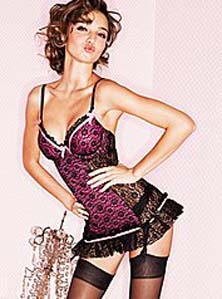 |
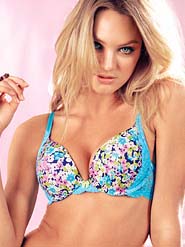 |
 |
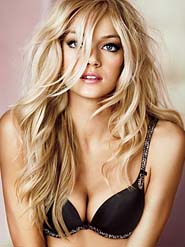 |
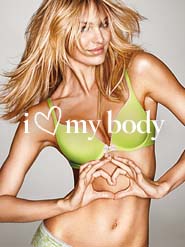 |
| Homepage | Psychoanalysis | Audience Studies | Interpellating Men/Women |
I Love My Body |
Rose, Gillian. "Visual Methodologies: An Introduction to the Interpretation of Visual Materials". 2nd ed. London: SAGE, 2007.
Thesander, Marianne. The Feminine Ideal. London: Reaktion, 1997. Print.
Tseelon, Efrat. The Masque of Femininity: The Presentation of Woman in Everyday Life. London: Sage Publications, 1995. Print.
Figure 1: http://www.flickr.com/photos/32143990@N00/315474076/
Figure 2: http://www.victoriassecret.com/
May 2, 2011